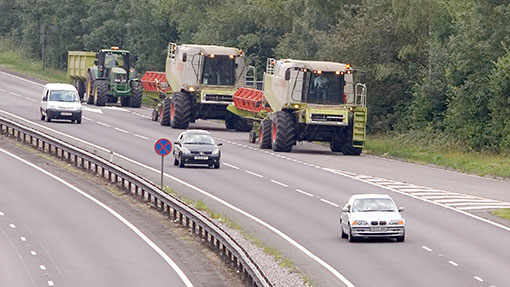How to keep your farm vehicle legal on the road

The rules and regulations for tractors and farm vehicles on the road can be a minefield and it’s easy to accidentally stray onto the wrong side of the law.
PC Paul Fisk from Essex traffic police provides David Cousins with some reminders to keep us all on the straight and narrow.
- Check you hold the right driving licence for the class of vehicle you are driving. A Category B (car) licence is suitable for all agricultural tractors with trailers or attached implements, regardless of weight, up to the current UK legal maximum of 31,000kg.
- If you’re 16 years old with a Category F (agricultural tractor) licence, you can only drive tractors up to a maximum width of 2.45m on the road and can only tow a trailer with two wheels or four close-coupled ones. You can’t drive a combine, self-propelled forager or self-propelled sprayer over 7.5t on the road until you are 21.
- You can only drive a vehicle that is steered by its tracks (for example Cat Challenger/John Deere RT) if you have a Category H (tracked vehicle) driving licence. Case-IH Quadtracs are exempt because the whole track unit turns.
- All indicators and stop lights fitted to the tractor and trailer should (a) work (b) be clean and (c) be used. You are legally bound to use amber flashing beacons on dual carriageways and PC Fisk recommends you use them on all roads, regardless of classification. You can never have too many reflective markings on trailers and wide load warning boards either.
- Do you want to have a trailer tyre go flat on you in mid-journey with 16t of superb milling wheat on board? No of course you don’t. So check your trailer tyres have the right amount of air in them and that they are road legal (still have decent tread on them). Exposed cord/ply and tears or bulges in the sidewall are definite no-nos, points out PC Fisk.
- Between loads, ease the boredom by giving the tractor cab glass a clean. It’s hell out there on the roads, so you need to have all the visibility you can get. There’s still time to change that cracked/bashed/wonky/missing side mirror, too.
- OK, rain is looming and you’re in a tearing hurry to get going, but taking a few seconds in the morning to check everything is securely attached and hydraulic pipes and trailer electrics are in working order could save you loads of stress. Ask anyone who has had a trailer ring jump off the hook because they haven’t locked it up properly.
- While most newish tractors are capable of doing 50kph (32mph), it’s worth bearing in mind that the legal limit for ag vehicles on roads is 40kph (25mph) for most tractors, with the exception of those higher-spec machines which are permitted to do up to 65kph (40mph). For more on tractor speed limits, see the DVLA website. If your tractor is involved in a collision, the technology is available to enable the police to look at the tractor’s CPU and see what speed you were doing at the time of the accident. Oh yes.
- Using a handheld mobile while driving on the road attracts the same £200 fine and six points as driving a car. You could also be taken to court, banned from driving or slapped with an even bigger fine of up to £1,000.
- We’re sure that this would never apply to Farmers Weekly readers, but the drink-drive laws apply to tractors as well as cars. A minimum one-year disqualification from driving, plus a fine of up to £5,000 and up to six months’ imprisonment (even if it’s your first conviction) won’t endear you to your boss (or dad).
See more

